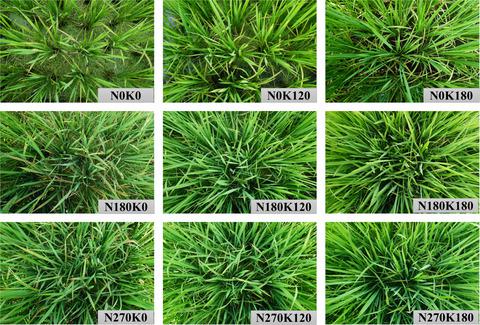当前位置:
X-MOL 学术
›
Food Energy Secur.
›
论文详情
Our official English website, www.x-mol.net, welcomes your
feedback! (Note: you will need to create a separate account there.)
Nitrogen/potassium interactions increase rice yield by improving canopy performance
Food and Energy Security ( IF 4.0 ) Pub Date : 2021-05-25 , DOI: 10.1002/fes3.295 Tinghong Ye 1, 2 , Jianglin Zhang 1, 2 , Jing Li 1, 2 , Jianwei Lu 1, 2 , Tao Ren 1, 2 , Rihuan Cong 1, 2 , Zhifeng Lu 1, 2 , Xiaokun Li 1, 2, 3
Food and Energy Security ( IF 4.0 ) Pub Date : 2021-05-25 , DOI: 10.1002/fes3.295 Tinghong Ye 1, 2 , Jianglin Zhang 1, 2 , Jing Li 1, 2 , Jianwei Lu 1, 2 , Tao Ren 1, 2 , Rihuan Cong 1, 2 , Zhifeng Lu 1, 2 , Xiaokun Li 1, 2, 3
Affiliation

|
The interactions between nitrogen (N) and potassium (K) are important determinants of rice yield, but the mechanisms involved remain poorly understood. For example, N/K interactions may influence light utilization and N distribution in the canopy. Field experiments were therefore performed to resolve this issue, using factorial combination of N and K. The interaction between N and K had a significant effect on the grain yield, N uptake, and the NUE of grain production (NUEg), and biomass production (NUEb). The application of either N or K alone resulted in lower yields than the combined application of these nutrients. The combined application of N and K increased rice yields by 54.5% in 2018 and by 76.1% in 2019, compared with N0K0. Similarly, N uptake, NUEg, and NUEb were higher when N was supplied with K than with N application alone. The higher grain yields, N uptake rates, and NUEs observed with the combined N and K treatment were attributed to the following: (1) a higher leaf area index that resulted in better light interception; (2) improved the coordination of light and N distribution within the canopy. Evidence for improved light use by photosynthesis is provided by the observed lower light extinction coefficient (KL), the higher specific leaf N in the top leaves (SLNo), higher extinction coefficients for effective leaf N (KN) and KN/KL values. We conclude that the interactions between N and K support higher yields by improving canopy performance even at lower N rates.
中文翻译:

氮/钾相互作用通过改善冠层性能提高水稻产量
氮 (N) 和钾 (K) 之间的相互作用是水稻产量的重要决定因素,但所涉及的机制仍知之甚少。例如,N/K 相互作用可能会影响树冠中的光利用和 N 分布。因此,通过田间试验,使用 N 和 K 的因子组合来解决这个问题。 N 和 K 之间的相互作用对粮食产量、N 吸收、粮食生产的 NUE (NUEg) 和生物量生产有显着影响。 NUEb)。单独施用 N 或 K 导致的产量低于这些营养素的组合施用。与N0K0相比,2018年和2019年N和K配施水稻增产54.5%和76.1%。类似地,当 N 与 K 一起供应时,N 吸收、NUEg 和 NUEb 比单独施氮时更高。N 和 K 联合处理观察到的更高的谷物产量、N 吸收率和 NUE 归因于以下原因:(1) 更高的叶面积指数导致更好的光拦截;(2) 改善了冠层内光氮分布的协调性。观察到的较低的消光系数提供了光合作用改善光利用的证据(K L ),顶部叶片中的特定叶片 N (SLN o ) 越高,有效叶片 N ( K N ) 和K N / K L值的消光系数越高。我们得出结论,即使在较低的 N 率下,N 和 K 之间的相互作用也能通过提高冠层性能来支持更高的产量。
更新日期:2021-05-25
中文翻译:

氮/钾相互作用通过改善冠层性能提高水稻产量
氮 (N) 和钾 (K) 之间的相互作用是水稻产量的重要决定因素,但所涉及的机制仍知之甚少。例如,N/K 相互作用可能会影响树冠中的光利用和 N 分布。因此,通过田间试验,使用 N 和 K 的因子组合来解决这个问题。 N 和 K 之间的相互作用对粮食产量、N 吸收、粮食生产的 NUE (NUEg) 和生物量生产有显着影响。 NUEb)。单独施用 N 或 K 导致的产量低于这些营养素的组合施用。与N0K0相比,2018年和2019年N和K配施水稻增产54.5%和76.1%。类似地,当 N 与 K 一起供应时,N 吸收、NUEg 和 NUEb 比单独施氮时更高。N 和 K 联合处理观察到的更高的谷物产量、N 吸收率和 NUE 归因于以下原因:(1) 更高的叶面积指数导致更好的光拦截;(2) 改善了冠层内光氮分布的协调性。观察到的较低的消光系数提供了光合作用改善光利用的证据(K L ),顶部叶片中的特定叶片 N (SLN o ) 越高,有效叶片 N ( K N ) 和K N / K L值的消光系数越高。我们得出结论,即使在较低的 N 率下,N 和 K 之间的相互作用也能通过提高冠层性能来支持更高的产量。











































 京公网安备 11010802027423号
京公网安备 11010802027423号